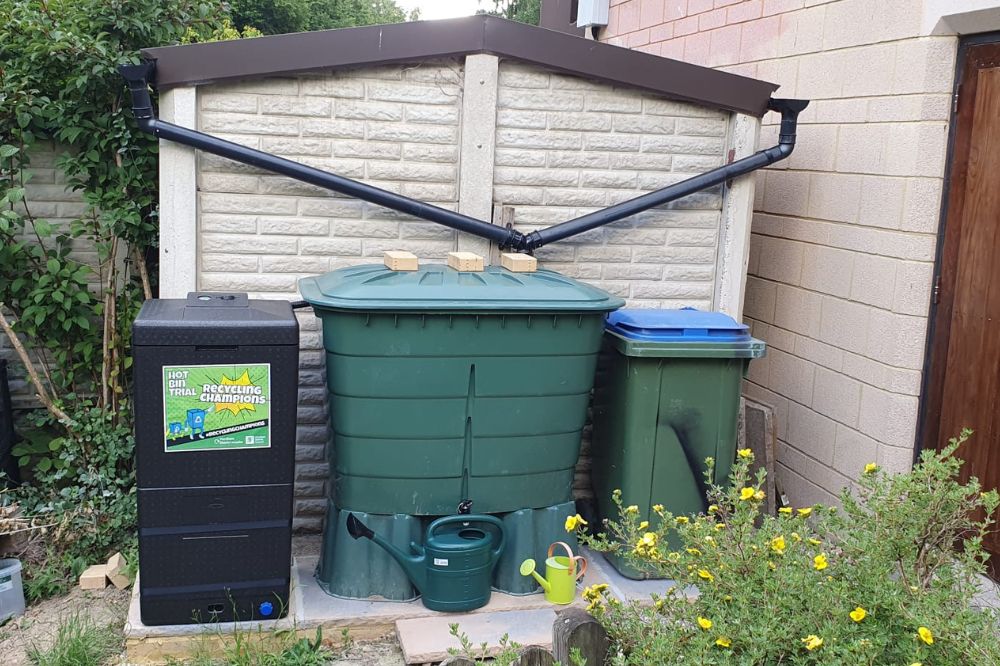In summer 2022, Horsham District Council extended its trial of Hot Bins with a particular focus on community composting. In the previous year we had trialled hot bins with several families, with success reported in using the new system to compost raw and cooked food waste. It was now time to step up the trial to explore its impact on community composting.
The Hot Bin trial
St. Marks Church in Horsham was one of the first community groups to trial a Hot Bin. Over 8 months, the community using the Hot Bin managed to divert 155kg of food from waste.
By separating food waste from general waste residents were also able to see more clearly how much was being wasted, encouraging food waste reduction through buying less, reducing portion sizes and using food-waste saving tips such as freezing food.
What is a Hot Bin?
A Hot Bin can take anything from cooked food waste (including bones) to peelings, tea bags and egg shells, and turn it into rich compost by heating the waste up to 60°C.
The result is a nutrient-rich compost for your garden.
St. Marks Church community group
St. Marks is the parish church of Holbrook, in Horsham, West Sussex. The church is part of Horsham Eco Churches who work together on sustainable projects for their community as well as hosting community events, including a pop-up café and summer barbecues. The church has a church garden as well as a community orchard.
How the trial worked
The Hot Bin trial information was shared with the community which the church supports, including the pre-school and nursery run out of the church hall. Enthusiastic recyclers would bring their food waste in to have it composted on site. The following feedback was received at the beginning of the trial:
“It is great to be participating in this Hot Bin trial which has sparked a lot of interest with people wanting to Hot Bin compost at home, or bring food waste from home to add to our bin! One family is considering having a bin in their front garden which their elderly neighbours could use too.”
As the trial went on, the church found there were issues with participants placing their food waste tied up in bags within the Hot Bin. For the Hot Bin to work, food needs to be chopped into 4cm sized pieces. This brought down the temperature and caused the church to change tac – they placed the Hot Bin out of site and instead installed a lidded storage bin for participants to place their food waste in. This is so one of the leading participants could mix the food waste with garden waste before it is placed in the Hot Bin, to give it the best chance of reaching temperature and composting.
Once this strategy was employed, the church found that the Hot Bin was again composting well and reaching temperature.
Separating food waste can reduce food waste
A lesser-known effect of separating food waste for either collection or composting is its ability to reduce the waste produced in the first place. Once food waste is no longer mixed in with other general rubbish it is more obvious how much is being wasted. This causes food waste reduction through buying less, reducing portion sizes and using food-waste saving tips such as freezing food - so helping the householder to save on their food bills too!
This effect was noticed by the vicarage participating in this trial as reported below:
“Richard commented that the vicarage food waste is going down, as by collecting it they are more aware of what they were wasting and I know that this is the experience of others when they start collecting food waste.”
Benefits of community composting
Apart from not producing food waste in the first place, composting is the next best way to deal with food waste. By composting at home, food waste is diverted from other forms of treatment, reducing greenhouse gas emissions from it being transported. The resulting compost also improves soil health.
Results of the community composting trial
This trial demonstrated that there was a keen interest in community composting. Despite several notices and information provided to members of St. Marks congregation, people continued to bring food waste in from home, eager to have in turned into useful compost. While the church recorded that they diverted 155kg of food waste, more was used as some used the Hot Bin without first weighing and recording what was being placed in it.
Having someone in charge of the Hot Bin and championing the trial was key to the Hot Bin being used successfully. Many of the trial participants, while reporting success also reported that you need to ensure it is being fed the correct mix of food waste, garden waste and shredded paper to achieve the high temperature required to break down the organic components and produce the nutrient-rich compost. Without the contents being screened by installing a storage bin, tied-up bags of food waste would have ended up in the mix and this would have brought the temperature down too much for the system to have worked.
This case study has shown that with the right intervention and management, community composting schemes can be a successful way to help bring communities together, reduce food bills, improve local soil health, and reduce the carbon impact of food waste.

